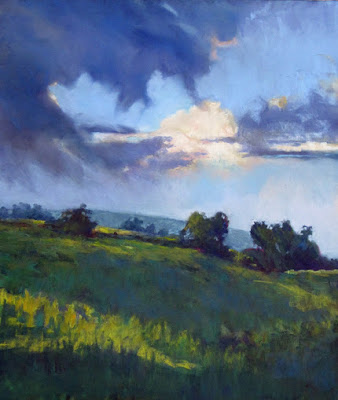Want to become a caricature of yourself? Just focus on your style rather than the content of your work.
 |
| Commissioned portrait, by Carol L. Douglas. In this instance, high-key lighting was necessary to convey the spirit of the model, and so I used it. |
Art & Fear, by David Bayles and Ted Orland, is a book that every artist should read. Not only does it destroy the myth of genius, it also points out that there is no end point in art making. The working artist can never rest on his laurels. Art-making is a constantly-renewing process of discovery. This is something that can be seen in the careers of every great master from
Rembrandt to
Monet.
A good artist investigates knotty questions. When they are answered, he moves on, just like
Omar Khayyam’s moving finger. So often, by the time we get through the cycle of making and mounting a body of work, we’re no longer that interested in it. We’ve moved on to another struggle.
 |
| Castine Lunch Break, by Carol L. Douglas. For many years, I was interested in patterning. Of course, I can only say that after the fact; I didn’t realize it at the time. |
Most of us (especially those who have worked as commercial artists) can mimic other painters. There’s also significant variation in how we approach painting problems. For example, I’ll occasionally paint in great detail, with lots of modeling. I was initially trained to paint that way, and I know enough about how paints handle to be able to blend and layer them.
However, what truly interests me right now is not mastering representation, but something far more visceral. This is more fundamental than style. Can I put a name to the question that’s currently bedeviling me? No; I’ve learned that is a shortcut to putting myself in a box. However, not being verbalized doesn’t make it any less real.
 |
| After the Storm, pastel, by Carol L. Douglas, is a very old work. Is it stylistically that different from my current work? I don’t think so. |
I discourage painting students from ‘embracing their style,’ because to me that’s a trap that they may not be able to escape. Sometimes, what people call style is just technical deficiency. For example, some painters separate their color fields with narrow lines—white paper in watercolor, dark outlines in oils. I’d like to know that they embraced this voluntarily, not because they never learned how to marry edges.
Mature artists don’t generally think about style. At that point, style is the gap between what they perceive and what comes off their brush. That’s deeply revelatory, and it can be disturbing when we see it in our own work.
 |
| Wreck of the SS Ethie, by Carol L. Douglas. This was painted in 2016, but would not have worked in a looser style, since the shipwreck and rocks provided the abstraction. |
Some of us try to cover that up with stylings, not realizing that those moments of revelation are what viewers hunger for. They—not the nominal subject of the piece—are the real connection between the artist and his audience.
There’s a difference between style and being stylish. I enjoy
Olena Babak’s ability to describe reflections in a single, fluid brush line. I feel the same way about
Kari Ganoung Ruiz’ emotive, energetic highlights. Neither of these are styles. They are, instead, self-confident skill, which results in stylish brush work.
 |
| Flood Tide, 2017, by Carol L. Douglas. Where am I going now? I’ll let you know. |
I do not admire painters who use the same scribing or pattern-making on the surface of every painting. It’s style for its own sake, and it often is just a ruse to cover up badly-conceived paintings.








